Albert Kahn Associates


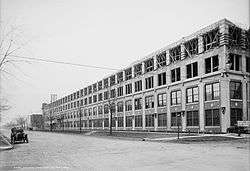
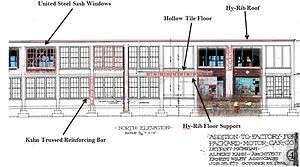
Albert Kahn Associates is an architectural design firm in Detroit, Michigan. It introduced a new technology in industrial building involving a unique reinforced concrete method referred to as the Kahn System of construction using proprietary patented reinforcement steel manufactured by Trussed Concrete Steel Company. The building of automobile factories and other types of factories were revolutionized from wooden timber framing construction. Besides being an advanced technology in strength that lead to wider open interior spaces it featured a high degree of fire resistance and larger window space for light. The firm started by Albert Kahn built factories for Chrysler for over a decade, Ford Automobile for 30 years and Packard Automobile for 35 years. Other important clients of the firm were Republic Steel and General Motors. The firm was awarded a forty million dollar contract to build a tractor factory in Russia in 1928. The firm's output was over a million dollars worth of work per week by 1929. By 1939 the firm designed 19 per cent of all industrial buildings in the United States and had designed some $800 million of buildings worldwide.[1]
History
Albert Kahn established the Detroit firm in 1895 and was its first and only employee then.[2] In 1896 Kahn took on two partners: George Nettleton and Alexander Trowbridge.[3] All three were architects at the time with the architectural firm Mason & Rice in Detroit. The firm they opened in January 1896 was initially called "Nettleton, Kahn, and Trowbridge".[3] At the time there was an abundance of design jobs available. Mason & Rice even referred some of their work over to Kahn's new firm when they had more than they could handle.[4]
The firm's first large design job in Detroit was to design Children's Hospital.[4] Its next major project came in 1898 from James E. Scripps to design an elaborate library with an art gallery. The Scripps Library and Museum was located adjacent to Scripps mansion home on Trumbull Avenue at Grand River Avenue.[5] The dynamics of the firm changed when Trowbridge took a position at Cornell University in 1897 and Nettleton died in 1900. The firm then hired designers with good reputations and able to work as a team with other designers. Ernest Wilby, a young Englishman from Canada, was their key designer working for the firm at the time.[6] This new team of the Kahn firm then collaborated with the Mason & Rice architectural firm to design the Palms Apartments, a building with English architecture on Jefferson Avenue at Rivard Street in Detroit. It was one of the first buildings to use reinforced concrete as a major construction material.[7]
The firm then changed its name in 1901 to "Albert Kahn, architect; Ernest Wilby, associate",[8] and had its first industrial design the same year. Joseph Boyer had hired the firm to design a factory that made pneumatic tools.[9] Boyer then asked the firm to design a building to house the Burroughs Adding Machine Company, where modern mechanical calculators were made.[9] Boyer in 1902 introduced Kahn to Henry Joy, head the Packard Motor Car.[10] The Albert Kahn Associates firm received several non-industrial jobs from Joy, including remodeling Joy's personal home.[10][11] Joy additionally had the firm design automobile factory buildings.[10][11]
Between 1903–05, the firm designed the first nine Packard Automotive Plant buildings using traditional wooden designs that had spans no longer than 14 feet (4.3 m).[12] Packard produced over 700 automobiles a year by 1905, so an expansion to the factory facilities was in order. A new type factory of reinforced concrete was decided upon.[13] Albert's younger brother Julius as the key architect and engineer, constructed building number 10 with the Kahn bar and other reinforced concrete products manufactured at the Trussed Concrete Steel Company (aka "Truscon") which provided 32-foot (9.8 m) spans.[11][14] This new technology for concrete changed the way American automobile factories were built from then on.[10][11] This building was built with uniquely designed steel beam reinforced concrete for reinforcement that used the Kahn bar with winged tabs on the steel bar edges that were bent back at 45 degrees to resist and counter tension stresses.[11][14][15] This was the first time reinforced concrete was used for automobile factory construction in the United States.[11][16][17] The new state of the art design concept featured larger open interior spaces than the old mill-framed wooden factory buildings.[18] The building was 322 feet long by 60 feet wide (about 98 meters by 18 meters).[11] This new factory concept of building with reinforced concrete lead to Albert Kahn Associates doing all the aviation factories for the government during World War I.[19]
In 1906, the firm designed factory buildings for the Pierce-Arrow Motor Car Company in Buffalo, New York.[20] In 1908 the Highland Park Ford Plant was designed by the firm.[21] It was similar to the Packard factory just a few miles away, however different from the Pierce-Arrow factory buildings that were of one-story only and had saw-tooth roofs with skylights. The Ford factory building had four stories. It was however, of reinforced concrete design using the patented Kahn System of his brother Julius, just like the Packard and Pierce-Arrow factory buildings. The Ford plant was 860 feet long and 75 feet wide.[10] The steel reinforced concrete building designs were fireproof.[10] The "Model factory" featured what was referred to as Truscon's "Daylight System" because of the many large windows.[22]
Henry Ford had the firm design his River Rouge automobile factory that started construction in 1917.[23] At the time Ford decided to make a ship factory for the United States Navy and had the firm design B Building.[23] This was called the Eagle Plant because it built Eagle Boats that were antisubmarine chasers that destroyed German submarines.[24] It was 100 feet (30 meters) high by 300 feet (91 meters) wide by 1700 feet (518 meters) long.[23] When World War I ended this factory plant was converted to make Ford automobiles.[24]
The firm designed over 50 factories between 1921 and 1929 and had a substantial quantity of work not related to industrial buildings. It had over 400 on the staff by 1930 and was producing a million dollars worth of construction a week.[25] The firm never hired an architectural college graduate until 1935.[10][25] Going into the twenty-first century the firm name is Albert Kahn Associates and has branches in Birmingham, Alabama, and São Paulo, Brasil.[26] The firm designed about two thousand structures between 1895 and 1945 of which twenty-six were buildings for the University of Michigan.[27]
Organizational layout
The firm had a staff of 300–400 people in the 1930s, including about 40 secretaries, stenographers, typists, and file clerks. There were around 175 architectural designers and draftsmen, 80–90 mechanical and electrical engineers, 40–50 field superintendents, and about 30 specification writers.[28] The chief administrator was Albert Kahn and his assistants were his brothers Julius, Moritz and Louis.[29] The staff was increased to 600 people at the time of World War II. The firm ramped up for war plants to make tanks and other war related equipment.[30]

The Technical Division had departments that designed the projects which included electrical, plumbing, heating and air-conditioning. This division was responsible for the functional design of the building. Key important design elements for factories included "straight-line" production capability, flexibility in interior floor designs to accommodate various changing production methods, generous column spacing to give maximum open floor space, high ceilings, strong floors to carry heavy loads, and with good lighting and ventilation.[31]
The Executive Division was responsible for the management of the projects. Business-like management was required for concerns of economics, speed, obtaining reliable sub-contractors, adequate supervision, and complete accurate drawings.[32]
Buildings designed
Below are some of the buildings designed by Albert Kahn Associates:
Palms Apartments
-

Palms Apartments c. 1902
-
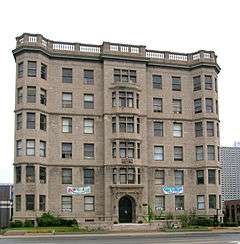
Palms Apartments 2008
Burroughs Adding Machine Company
-

St Louis, Missouri, designed in 1903
-

St Louis building, circa 1904
-

Detroit, Michigan, designed in 1905
-

Detroit, Michigan, designed in 1915
-
Plymouth, Michigan, designed in 1938[1]
- ^ Ferry 1970, p. 25.
University of Michigan School of Engineering
-

Main entrance, circa 1905
-

Courtyard, circa 1906
Packard Building #10
-

Packard factory plant complex, circa 1904
-

Packard plant #10, c.1905
-

Packard plant #10 in 2012
-

Packard plants comparing #1–9 (1903) & #10 (1905)
-

Packard factory number 10 interior, circa 1906
Detroit Free Press Building
-

Detroit Free Press front
-
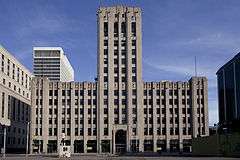
Detroit Free Press complex
Ford River Rouge automobile factory buildings
-
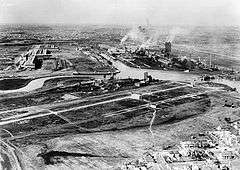
Ford River Rouge aerial
-

1200 acre manufacturing
National Bank of Detroit Building
-

Woodward Avenue façade
See also
| Wikimedia Commons has media related to Albert Kahn Building. |
References
- ↑ Nelson 1939, pp. 15-18.
- ↑ Bucci 2002, p. 24.
- 1 2 Bucci 2002, p. 30.
- 1 2 Matuz 2002, p. 40.
- ↑ Matuz 2002, p. 41.
- ↑ Bucci 2002, p. 151.
- ↑ Matuz 2002, p. 42.
- ↑ Matuz 2002, p. 43.
- 1 2 Matuz 2002, p. 45.
- 1 2 3 4 5 6 7 "Rosie the Riveter National Historical Park, Ford Assembly Plant No. CA-326-H" (PDF). Library of Congress Prints & Photographs Online. Historic American Engineering Record, National Park Service, U.S. Department of the Interior. 1968. Archived from the original (PDF) on 2014-08-10. Retrieved 2014-07-30.
- 1 2 3 4 5 6 7 Bucci 2002, p. 33.
- ↑ Hildebrand 1974, pp. 28-29.
- ↑ Atlas 1907, p. 131.
- 1 2 Sedlar, Frank (April 23, 2013). "Engineering Industrial Architecture / The Trussed Concrete Steel Company and Albert Kahn" (PDF). U of M Library. University of Michigan. Retrieved 2014-07-30. "The Packard #10 building was the first to utilize reinforced concrete with Julius Kahn's Kahn Bar but also as previously discussed, the full range of steel building products from the Trussed Concrete Steel Company."
- ↑ Hildebrand 1974, p. 29.
- ↑ Hildebrand 1974, p. 31 "Thus Plant Number Ten represented a clear advance in factory construction for Packard and for the automobile industry in general, as it was the first automobile plant to be built of reinforced concrete".
- ↑ Nelson 1939, p. 17 "The Packard job was the first reinforced concrete factory in America, and for the first time an industrialist got a plant in which fenestration was reasonably adequate and production departments were coordinated with an eye to efficiency'".
- ↑ Matuz 2002, p. 51.
- ↑ Nelson 1939, p. 17 By the time America entered the war the office was large enough to take over all of the government's aviation work.
- ↑ Bucci 2002, p. 37-49.
- ↑ Bucci 2002, p. 37.
- ↑ Skinner 1997, p. 15.
- 1 2 3 Bucci 2002, p. 50.
- 1 2 Matuz 2002, p. 59.
- 1 2 Hildebrand 1974, p. 126.
- ↑ "About Kahn:Where". Albert Kahn, family of companies. Albert Kahn Associates. 2014. Retrieved 2014-07-20.
- ↑ Bucci 2002, p. 24, 151.
- ↑ Nelson 1939, p. 19.
- ↑ Nelson 1939, p. 21.
- ↑ Ferry 1970, p. 25.
- ↑ Nelson 1939, pp. 19, 20, 24.
- ↑ Nelson 1939, pp. 20, 21, 24.
Bibliography
- Atlas, Portland Cement Company (1907). Reinforced concrete in factory construction. New York: The Atlas Portland Cement Company.
- Bucci, Federico (2002). Albert Kahn: Architect of Ford. Princeton Architectural Press. ISBN 978-1-56898-343-1.
- Ferry, W. Hawkins (1970). The Legacy of Albert Kahn. Wayne State University Press. ISBN 0-8143-1889-4.
- Hildebrand, Grant (1974). Designing for industry: the architecture of Albert Kahn. The MIT Press. ISBN 978-0-262-08054-5.
- Matuz, Roger (2002). Albert Kahn: Builder of Detroit. Wayne State University Press. ISBN 0-8143-2957-8.
- Nelson, George (1939). Industrial architecture of Albert Kahn, inc. Architectural Book Publishing Company, inc.
- Skinner, Joan S. (1997). Form and Fancy: Factories and Factory Buildings by Wallis, Gilbert & Partners, 1916–1939. Liverpool University Press. ISBN 978-0-85323-612-2.
External links
- Video on "Engineering Industrial Architecture: Albert Kahn and the Trussed Concrete Steel Company"
- Michigan Historical Collections, Bentley Historical Library, University of Michigan, Albert Kahn Papers, 1896–2011
